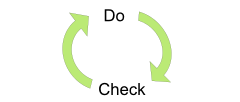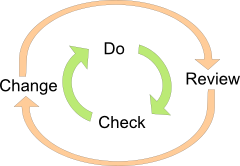
| Previous | Next | Printer friendly |
Standards: two loops are better than one
To stop standards becoming a bureaucratic monster, spend at least 10% of standards effort on reviewing and changing the standards themselves.
I like standards. I like standards for processes, like ITIL. I like standards for outcomes, like system quality management.
I like standards because they make life easier. They provide guidance for unfamiliar situations. They provide a pattern of good practice that can be easily adopted. They are a great tool for improving overall capability.
Standards work by prescribing how the work should be done, often setting criteria against which work should be checked.

For standards to work, the organisation has to commit to this control cycle. Management must enforce the standards or the standards will wither away.
There is a danger, though, that in our enthusiasm to follow the standards, we let them become our masters. They turn from being a valuable tool of management, to a bureaucratic monster that has to be constantly fed with time and management attention, but gives little back in return.
To avoid this, you need two loops.

As well as committing to a process of following the standards, you have to commit to a process of reviewing and changing standards.
This outer process is not just there to make standards more rigorous, but to make the standards more valuable, more efficient, and more accepted. You should:
- Remove anything from the standard that does not add value.
- Make the standard more specific to your organisation, to provide more precise guidance.
- Move on. Change the standards to tackle tomorrow's challenges, not yesterday's.
- Institutionalise what you have learned.
The second loop moves standards from being solely a quality assurance and control activity, to being a vehicle for setting direction and organisational learning.
When you are reviewing and changing standards, focus on difficulties, even if this means ignoring the enthusiasts.
- Capture complaints. Even the common complaint that standards are bureaucratic is really important to consider. More standards die from being too bureaucratic than from being too simple.
- Ask what the standards deliver. Does it help you do things right, does it get things wrong, does it miss things out? Is it all obvious, anyway?
- See what competing processes and standards have been set up. Better to understand what drives them to be different, and bring them into the camp.
The aim of the review process is to understand what's really going on, and to fight both indifference and bureaucracy, not to reassert the purity and rigour of the standards.
Reviewing and changing standards is critical. The time and money you spent on writing or buying in standards will soon be lost unless you make sure the standards stay relevant and accepted in the organisation. You must build the review of the standards into the standards processes themselves.
Reviewing standards takes time and management attention. As a rough guide, if you add up all the time you spend on standardisation (promoting and enforcing the standards, and using them to check work), then reviewing and changing the standards should be at least 10% of this time. Spending this time on a second control loop for the standards themselves can stop the standards withering, and prevent them growing into a bureaucratic monster.
Next: The business value of ITSubscription
Latest newsletter:
Magical metadata
We use the term "metadata-driven" to describe IT solutions in which functionality is defined in data. Taking this to the extreme can provide unparalleled levels of speed, simplicity and versatility.
Read full newsletter
System governance
System governance helps you implement high-quality systems, manage existing systems proactively, and improve failing systems.
Copyright © 2005-2015 Minimal IT Ltd. All rights reserved.
Minimal IT: research, training, consultancy and software to reduce IT costs.
